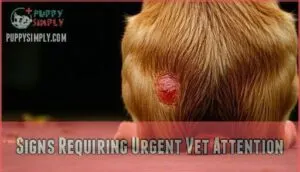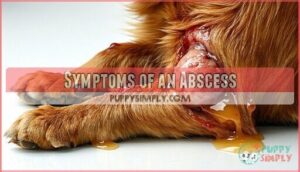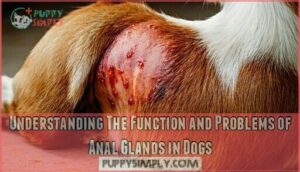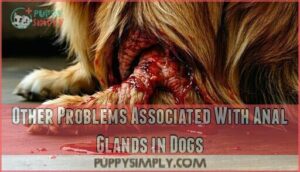This site is supported by our readers. We may earn a commission, at no cost to you, if you purchase through links.
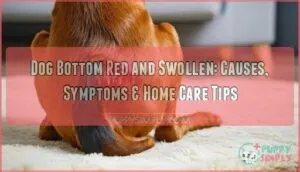 A dog bottom red and swollen usually signals anal gland problems, allergies, or irritation from loose stools.
A dog bottom red and swollen usually signals anal gland problems, allergies, or irritation from loose stools.
You’ll notice your pup scooting across the floor, excessive licking, or straining to defecate.
While mild cases respond well to gentle cleaning and dietary adjustments, watch for severe swelling, bleeding, or signs of pain that need immediate vet attention.
Simple home care like keeping the area clean and using a bland diet can help, but don’t ignore persistent symptoms, as the key is knowing when you’re dealing with a minor irritation versus something more serious that requires professional treatment, which is crucial for immediate vet attention.
Table Of Contents
- Key Takeaways
- Causes of Dog’s Red and Swollen Bottom
- Symptoms and Urgent Care for Red and Swollen Dog Bottom
- When to Be Concerned About a Dog’s Red and Swollen Bottom
- Home Care for a Dog With a Red and Swollen Bottom
- Preparing for a Veterinary Visit for a Dog With a Red and Swollen Bottom
- Reasons for a Swollen Rear End in Dogs
- Symptoms and Treatment of an Abscess on a Dog’s Bottom
- Home Remedies for a Dog’s Itchy Bum
- Understanding The Function and Problems of Anal Glands in Dogs
- Other Problems Associated With Anal Glands in Dogs
- Frequently Asked Questions (FAQs)
- How do you treat an inflamed perianal gland in a dog?
- Why is my dog’s bottom red raw?
- What can I put on my dog’s red bottom?
- Can puppies get red swollen bottoms differently?
- How long does bottom inflammation typically last?
- Are certain dog breeds more prone to this?
- Can spaying/neutering affect bottom swelling issues?
- What foods commonly trigger bottom inflammation reactions?
- Conclusion
Key Takeaways
- Watch for emergency signs – If you notice severe bleeding, prolapsed tissue, high fever, or your dog cannot defecate, get immediate vet care since these indicate serious conditions requiring professional treatment.
- Start with gentle home care – You can clean the area with warm water, apply vet-approved ointments, and use an E-collar to prevent excessive licking for mild redness and swelling.
- Anal gland problems are common culprits – Scooting, excessive licking, and foul odors often signal impacted or infected anal glands that need professional expression or treatment.
- Don’t ignore persistent symptoms – If home remedies do not improve the condition within 2-3 days or symptoms worsen, contact your vet since underlying issues like allergies, infections, or tumors require proper diagnosis and treatment.
Causes of Dog’s Red and Swollen Bottom
A red and swollen bottom in dogs can happen for several reasons, from simple diarrhea to more serious conditions like anal gland disease or infections.
Understanding what’s causing your dog’s discomfort helps you decide whether you need immediate vet care or can start with home remedies.
Diarrhea
Diarrhea often causes inflammation around your dog’s bottom.
When loose stools repeatedly irritate the sensitive anal area, redness and swelling develop.
This digestive issue creates a painful cycle – the more your pup strains, the worse the inflammation becomes.
Managing diarrhea through dietary changes, proper hydration, and probiotics helps reduce bottom irritation.
Consider bland foods and medication options if symptoms persist.
Anal Gland Disease
Anal gland disease affects 12% of dogs, causing chronic discomfort when these small sacs become impacted or infected.
Your dog’s red swollen dog anus and scooting problems signal this common condition requiring attention.
- Gland Expression – Professional drainage relieves dog anal gland issues and prevents painful buildup
- Impaction Causes – Poor diet, genetics, and obesity contribute to dog anal sac disease development
- Abscess Treatment – Veterinary care addresses infections before they worsen, avoiding Surgical Risks from delayed treatment
Perineal Cancers
Unfortunately, your dog’s bottom might harbor malignant tumors that require immediate veterinary attention.
These perianal tumors affect intact males three times more often than females, especially older dogs. Early detection through regular checkups helps identify suspicious lumps before they spread.
These tumors can be either benign or malignant, so early diagnosis is essential.
| Cancer Types | Tumor Growth Pattern | Treatment Options |
|---|---|---|
| Perianal adenomas | Slow, hormone-dependent | Surgery + neutering |
| Perianal adenocarcinomas | Aggressive, invasive | Surgery + chemotherapy |
| Anal gland cancer | Variable spread rate | Surgical removal |
Allergies
When allergies trigger your dog’s bottom inflammation, you’re dealing with their immune system overreacting to specific triggers.
Food allergens and environmental allergies create uncomfortable allergy symptoms that need proper identification.
Common allergy triggers include:
- Specific proteins in dog food allergies
- Pollen, dust mites, or mold spores
- Chemical cleaners or fabric softeners
- Flea saliva causing pet allergies
Professional allergy testing helps pinpoint exact causes, while targeted allergy relief through elimination diets or antihistamines addresses dog skin allergies effectively, considering the role of the immune system and the need for proper identification.
Rectal Prolapse
When your dog’s rectal tissue pushes outside the anus, that’s rectal prolapse.
This dog bottom red and swollen condition happens when weak anal muscles can’t hold everything in place.
Straining from diarrhea or constipation often triggers prolapse.
Early prolapse stages may resolve with treatment, but severe cases need surgical options.
Post-op care includes preventing strain and monitoring healing.
Prevention tips include managing digestive health and maintaining proper weight to reduce prolapse causes.
Symptoms and Urgent Care for Red and Swollen Dog Bottom
When your dog’s bottom becomes red and swollen, recognizing the difference between urgent situations and mild irritation can save your pet from unnecessary discomfort.
Some symptoms require immediate veterinary attention, while others can be managed at home with proper care.
Signs Requiring Urgent Vet Attention
When your dog’s bottom becomes red and swollen, certain warning signs demand immediate veterinary attention.
Red, swollen bottoms in dogs signal trouble that needs your immediate attention.
Severe pain that causes crying or yelping when touched signals a serious problem** requiring urgent care.
If you notice persistent bleeding from the anal area or blood dripping continuously, don’t wait to seek help.
A prolapsed rectum appears as a red, tube-like mass protruding from the anus and needs emergency treatment.
Watch for behavioral changes like refusal to eat, lethargy, or withdrawal from normal activities.
High fever combined with anal swelling indicates potential infection that could spread throughout the body.
Dogs experiencing loss of bowel control or inability to defecate properly need immediate evaluation.
Visible pus discharge, especially with a strong odor, can indicate a serious anal gland infection.
Excessive dog scooting problems, constant dog licking anus behavior, or visible abscesses require professional intervention.
Don’t hesitate to contact your vet for dog bottom issues when symptoms worsen rapidly or home care fails to improve the condition within 24-48 hours.
Mild Cases of Anal Inflammation
When your dog’s bottom shows mild inflammation, you’ll notice scooting and excessive licking behavior.
These gentle cases of dog bottom inflammation don’t require emergency treatment but need consistent care to prevent worsening.
Here’s your action plan for managing inflamed dog bottoms:
- Topical Treatments: Apply petroleum jelly or vet-approved ointments to reduce redness and swelling
- Dietary Adjustments: Switch to bland foods temporarily, then add fiber-rich options for better gland emptying
- Hygiene Practices: Keep the area clean with gentle wipes after bathroom breaks
- Probiotic Benefits: Support digestive health with dog-safe probiotics to reduce inflammation
- Stress Reduction: Minimize anxiety triggers that can worsen dog itching bottom symptoms
Monitor your pet’s comfort level daily. If the redness persists beyond three days or worsens, contact your veterinarian for professional guidance.
When to Be Concerned About a Dog’s Red and Swollen Bottom
Spotting red flags early can save your pup from serious complications.
When dog bottom inflammation progresses beyond mild irritation, certain Severity Indicators demand immediate veterinary attention.
| Severity Level | Symptoms | Action Required |
|---|---|---|
| Mild | Light redness, occasional itching | Monitor, gentle cleaning |
| Moderate | Swollen butt, persistent licking | Home care, vet if worsening |
| Severe | Blood, discharge, fever | Immediate veterinary care |
| Emergency | Rectal prolapse, severe pain | Emergency vet visit |
| Chronic | Prolonged Discomfort over weeks | Specialist referral needed |
Watch for Systemic Signs like lethargy or appetite loss alongside your dog’s swollen, irritated bottom.
If Home Treatment Failures persist after 2-3 days, or Worsening Symptoms include fever, bloody discharge, or your dog anus red and severely inflamed, don’t wait.
When inflamed dog bottoms show signs of infection or your dog itching bottom becomes obsessive, professional intervention prevents complications.
Home Care for a Dog With a Red and Swollen Bottom
When your dog has a red and swollen bottom, proper home care can help ease their discomfort and prevent the condition from worsening.
You’ll need to focus on keeping the area clean, managing any underlying issues like diarrhea, and preventing your dog from making the irritation worse through excessive licking, which is crucial for preventing the condition from worsening.
Keeping The Dog’s Hind End Clean
Proper hygiene plays a vital role when your dog has a swollen butt or inflamed dog bottoms. Regular cleaning prevents bacteria buildup that worsens irritation.
Essential cleaning steps for your dog’s comfort:
- Gentle wiping – Use unscented, pet-safe wipes after each bowel movement
- Warm water rinses – Rinse the dog anus red areas with lukewarm water daily
- Hair trimming – Keep fur around the irritated area short to prevent matting
- Grooming importance – Schedule professional groomers for thorough cleaning when needed
- Hygiene products – Choose mild, veterinarian-approved cleansers for sensitive skin
Regular checks help you monitor healing progress while preventing further complications from dog itching behaviors.
Using Over-the-counter Ointments
Several over-the-counter ointments can provide relief for your dog’s inflamed bottom.
Hydrocortisone cream reduces swelling, redness, and itching when applied sparingly to external areas.
Natural alternatives like aloe vera gel or coconut oil offer anti-inflammatory benefits with antimicrobial properties.
Application techniques matter—clean the area first, apply thin layers, and prevent licking for thirty minutes.
You can find dog hydrocortisone cream at many retailers.
Potential risks include delayed healing from overuse and toxicity if ingested.
OTC limitations mean these work best for mild , superficial irritation.
Severe discharge or persistent symptoms require vet alternatives with stronger prescription formulations.
Bland Diet for Diarrhea
When your dog’s bottom becomes red and swollen from diarrhea, a bland diet can work wonders.
Cook plain white rice with boiled chicken or turkey, serving small portion sizes every few hours.
This combination soothes digestive issues while providing essential nutrients.
Maintain proper hydration importance by offering fresh water frequently.
After symptoms improve, begin gradual reintroduction of regular food to prevent recurring problems, ensuring a smooth transition back to normal digestive issues management.
Using an E-collar to Prevent Licking
An Elizabethan collar prevents your dog from licking inflamed areas, allowing healing to begin.
Proper E-collar sizing guarantees comfort while blocking access to the swollen bottom.
With supervision needed during adjustment, most dogs adapt within days.
To find the right fit, consider dog e-collar dimensions for maximum comfort and effectiveness.
Essential E-collar considerations:
- Size matters – A poorly fitted collar causes neck strain and doesn’t prevent licking effectively
- Your dog’s distress – Watch for signs of panic, excessive drooling, or inability to eat comfortably
- Supervision needed – Monitor closely during the first 24 hours as dogs adjust to restricted movement
- Reintroduction process – Gradually remove the collar for short periods to check healing progress
Alternative collars like inflatable donuts work for some dogs but may not block determined lickers.
Long-term use isn’t recommended – most inflammation resolves within a week with proper care.
Preparing for a Veterinary Visit for a Dog With a Red and Swollen Bottom
While home care can help with mild symptoms, some situations require professional veterinary care to prevent complications.
Getting ready for your vet visit helps facilitate your dog receiving proper treatment quickly.
Here’s what you should prepare before heading to the clinic:
- Document your symptom timeline – Write down when the redness and swelling first appeared, how it’s progressed, and any triggers you’ve noticed.
- Gather medication history – Bring a list of all current medications, supplements, and recent treatments your dog has received.
- Note diet changes – Record any new foods, treats, or dietary modifications that occurred before the inflammation started.
- Track behavioral changes – Document changes in appetite, energy levels, bathroom habits, or unusual scooting and licking behaviors. If your dog is also experiencing sudden behavioral changes, be sure to inform your veterinarian.
- Prepare your questions list – Write down specific concerns about the swelling, treatment options, and prevention strategies you want to discuss.
This preparation helps your vet diagnose the underlying cause of your dog’s discomfort and develop an effective treatment plan for their dog health needs.
Reasons for a Swollen Rear End in Dogs
Several factors beyond medical conditions can cause your dog’s bottom to become red and swollen.
Understanding these common triggers helps you identify what might be affecting your pet and take appropriate action.
Overgrown Hair
Long fur around your dog’s bottom creates a perfect storm for problems.
When hair becomes matted, it traps fecal material and moisture, leading to skin irritation and bacterial growth.
Regular grooming prevents these issues from developing into painful infections.
| Grooming Task | Frequency | Breed Specifics |
|---|---|---|
| Preventative Trimming | Monthly | Golden Retrievers, Poodles |
| Brushing | Weekly | Long-haired breeds |
| Professional Grooming | Every 6-8 weeks | Double-coated dogs |
| Spot Cleaning | As needed | All breeds |
| Matting Removal | Immediate | Cocker Spaniels, Shih Tzus |
Fecal trapping occurs when matted hair creates pockets where waste accumulates.
This leads to dirt buildup and potential skin breakdown.
Watch for clipper burns if you’re trimming at home—they can worsen inflammation.
Grooming Issues
How can poor grooming practices turn your dog’s bottom into a painful mess? When grooming goes wrong, your pup suffers the consequences through inflamed dog bottoms and serious discomfort.
Common grooming mistakes that cause anal gland problems include:
- Clipper burns from inexperienced handling or dull blades
- Matting prevention failures that trap bacteria and waste
- Breed-specific grooming neglect, especially for long-haired dogs
- Grooming tools that aren’t sanitized between uses
Professional groomers understand how overgrown hair around the anal area creates perfect breeding grounds for infection. When you skip regular trimming, fecal matter gets trapped, causing skin irritation and potentially leading to dog anal gland infection.
The matted hair pulls at sensitive skin, creating small wounds that invite bacteria. To prevent these issues, consider investing in quality dog grooming supplies.
Proper grooming isn’t just about appearance—it’s essential healthcare. Regular trimming prevents anal gland issues by keeping the area clean and allowing natural gland expression during bowel movements.
Flea Infestation
Fleas can turn your dog’s bottom into an itchy, inflamed mess.
These tiny parasites cause Flea Allergy Dermatitis, creating red patches and intense skin irritation.
Understanding the flea life cycle helps you prevent reinfestation—eggs, larvae, and pupae hide in carpets and furniture.
Check for black specks in your dog’s fur and consider professional treatment options for effective flea prevention and tick control.
Worms
Worm infections can irritate your dog’s bottom and cause uncomfortable scooting behavior. Tapeworms and hookworms are common culprits that create anal inflammation.
Here’s what you need to know:
- Schedule regular fecal exams – Your vet can identify worm types through testing
- Follow a deworming schedule – Preventative medication protects against future infections
- Control the environment – Clean up waste promptly to prevent reinfection
Watch for zoonotic risk since some worms transfer to humans.
Breed
Some breeds face higher risks for anal gland problems due to breed predisposition.
German Shepherds develop anal furunculosis more often, while small breeds like Chihuahuas struggle with impaction.
Brachycephalic breeds need extra breed grooming attention around their tail pockets.
Allergy-prone breeds benefit from specialized breed diet management to prevent autoimmune disorder complications affecting their sensitive anal regions.
Symptoms and Treatment of an Abscess on a Dog’s Bottom
An abscess on your dog’s bottom appears as a red, swollen, painful lump that may rupture and release pus or blood.
You’ll need to apply warm compresses and seek veterinary care promptly, as abscesses require professional drainage and antibiotic treatment to prevent serious complications.
Symptoms of an Abscess
When your dog develops a dog anal gland abscess, you’ll notice unmistakable signs that demand immediate attention.
Pain assessment reveals your pup whimpering, reluctant to sit, or showing obvious discomfort when touched near their rear.
Swelling severity appears as a large, hot, firm bump beside the anus. Discharge characteristics include thick, bloody, or pus-filled fluid with a distinctly foul smell.
Fever monitoring becomes important as your dog may feel warm and act lethargic. The abscess location typically sits at the four or eight o’clock position around the anal opening.
These anal gland issues create visible distress and require prompt veterinary intervention. They demand immediate attention due to the obvious discomfort they cause.
Home Treatment for an Abscess
When your dog develops a dog anal gland abscess, swift home care can make all the difference.
Here’s your action plan:
- Apply warm compresses for 5-10 minutes, 4-5 times daily to promote drainage and provide pain relief medication benefits
- Clean with saline solution (1 teaspoon salt per cup warm water) to flush debris
- Use calendula mixture or coconut oil as soothing ointment** for healing support
- Add fiber benefits through diet to prevent future issues
- Consider silica dosage** (6C) for natural gland expression
Remember, antibiotics may still be needed from your vet.
Home Remedies for a Dog’s Itchy Bum
When your dog’s bottom becomes itchy, several gentle home remedies can provide relief. Start with simple solutions that address the root cause while soothing the irritated area.
Here are three effective approaches you can try:
- Soothing baths with chamomile or oatmeal – These natural ingredients reduce inflammation and calm irritated skin. Add chamomile tea or colloidal oatmeal to lukewarm water for a 10-minute soak.
- Apply coconut oil or aloe vera – Both offer anti-inflammatory properties and create a protective barrier. Use small amounts on clean, dry skin around the affected area.
- Dietary changes and herbal supplements – Adding fiber-rich foods helps firm stools, while omega-3 supplements reduce inflammation. Consider probiotics to support digestive health.
Addressing potential environmental allergy triggers may also provide relief. Weight management and stress reduction also play vital roles in preventing inflamed dog bottoms.
Keep the area clean and dry between treatments, and monitor for improvements. If symptoms persist beyond a few days or worsen, consult your veterinarian for proper diagnosis and treatment.
Understanding The Function and Problems of Anal Glands in Dogs
Your dog’s anal glands are small sacs located on either side of the anus that release scent when your pet defecates, but these glands can become impacted, infected, or abscessed when they don’t empty properly.
Understanding how these glands work and recognizing the signs of problems can help you address issues before they become serious and require emergency veterinary care, which is crucial for preventing complications and ensuring your pet’s health and well-being, especially in cases where emergency veterinary care is necessary.
Symptoms of Anal Sac Problems
Usually, your dog’s anal sac problems start with subtle signs that gradually worsen.
Watch for anal licking, scooting behavior across floors, and foul odor from their rear end. The swelling severity varies from mild redness to painful inflammation.
| Early Signs | Moderate Problems | Severe Issues |
|---|---|---|
| Excessive anal licking | Visible swelling, redness | Painful abscesses, bleeding |
| Scooting on carpet | Strong fishy odor | Difficulty sitting or defecating |
| Mild discomfort | Frequent bottom-dragging | Emergency vet attention needed |
These pain indicators signal your dog’s anal gland problems need immediate care.
Treatment for Anal Sac Disease
When anal sac disease strikes, veterinary care offers several treatment options.
Gland expression helps empty blocked sacs, while antibiotic options target infections.
Steroid use reduces inflammation, and dietary fiber promotes natural emptying.
For severe anal gland problems, surgical removal becomes necessary.
Your vet will recommend the best approach for your dog’s specific anal gland issues.
Recurrence of Anal Sac Issues
Even after successful treatment, anal sac disease often returns because underlying causes persist.
Dietary Influence plays a vital role—adding fiber helps create firmer stools for natural gland expression.
Regular Expression Frequency and consistent Preventative Measures reduce recurrence risk.
Long-term Management requires monitoring for early signs of anal gland problems and maintaining proper hygiene to prevent future inflammation.
Risks of Surgical Removal of Anal Glands
Surgical removal represents the final option when other treatments fail, but it carries significant risks that require careful consideration.
Your veterinarian will weigh these potential complications against your dog’s quality of life before recommending this procedure.
Potential surgical complications include:
- Incontinence risk – temporary or permanent loss of bowel control
- Infection potential – post-operative bacterial complications at the surgical site
- Fistula formation – abnormal connections between tissues that won’t heal properly
- Nerve damage – affecting sensation and muscle control around the anal area
- Scarring effects – tissue changes that may cause ongoing discomfort or dysfunction
Self-expression of Anal Glands in Dogs
Some dogs naturally express their anal glands during bowel movements, while others need help.
Manual techniques can assist impacted anal glands, but breed predisposition affects success rates.
Natural expression through dietary influence works best – firm stools help empty anal sacs effectively.
However, complications risk increases with improper handling, so professional anal gland expression remains safest for persistent anal gland issues, particularly those involving improper handling.
Other Problems Associated With Anal Glands in Dogs
Beyond typical anal gland issues, your dog can face more serious complications that require immediate attention.
Glandular tumors and perianal tumors may develop, causing persistent discomfort and visible swelling.
Anal fistulas create painful tunnels that won’t heal on their own, while chronic impaction leads to recurring problems that standard treatments can’t resolve.
Ruptured abscesses present emergency situations with pus, blood, and intense pain around your dog’s rear end.
Dog anal gland cancer, though rare, spreads quickly and demands aggressive treatment.
Perianal fistula dog cases often require multiple surgeries and lengthy recovery periods.
One common sign of anal gland issues is dog anal glands scooting.
Surgical complications can arise from routine procedures, creating additional problems like scarring or nerve damage.
Dog rectal prolapse may occur when straining becomes severe, and rectal tumors can obstruct normal bowel movements.
These conditions typically require specialized veterinary care, advanced diagnostics, and sometimes referral to veterinary specialists for proper management and treatment.
Frequently Asked Questions (FAQs)
How do you treat an inflamed perianal gland in a dog?
Like a soothing balm on a burning wound, treating your dog’s inflamed perianal gland requires gentle care and professional attention.
You’ll need veterinary examination, possible antibiotics, anal gland expression, and consistent hygiene maintenance.
Why is my dog’s bottom red raw?
Your dog’s bottom appears red and raw due to anal gland issues, allergies, infections, parasites, or excessive licking.
The irritation creates a painful cycle that worsens without proper treatment and veterinary care.
What can I put on my dog’s red bottom?
Just as a garden needs gentle care when its flowers wilt, you can soothe your dog’s irritated bottom with warm compresses.
Gentle cleaning using unscented wipes, and applying vet-approved topical treatments like calendula or coconut oil after consulting your veterinarian.
Can puppies get red swollen bottoms differently?
Yes, puppies can develop red, swollen bottoms differently than adult dogs.
They’re more prone to parasites, diarrhea from dietary changes, and infections due to their developing immune systems and exploratory behaviors.
How long does bottom inflammation typically last?
Max, a Golden Retriever, experienced swollen bottom inflammation that cleared up in five days with proper care.
Your dog’s bottom inflammation typically lasts 3-7 days with treatment, though severe cases may need 1-2 weeks to heal completely with proper care.
Are certain dog breeds more prone to this?
Certain breeds face higher risks due to their anatomy and genetics.
Bulldogs, German Shepherds, and Cocker Spaniels commonly develop anal gland problems, while breeds with thick coats around their rear ends experience more hygiene-related inflammation issues.
Can spaying/neutering affect bottom swelling issues?
Spaying and neutering don’t directly cause bottom swelling, but they can affect your dog’s weight and hormone levels.
Weight gain after surgery might increase pressure on anal glands, potentially leading to impaction issues.
What foods commonly trigger bottom inflammation reactions?
Common food triggers for bottom inflammation include beef, chicken, dairy products, wheat, corn, and soy.
You’ll also want to watch for artificial additives, preservatives, and high-fat treats that can upset your dog’s digestive system.
Conclusion
Like a lighthouse warning ships of hidden rocks, your dog’s red and swollen bottom signals potential health issues that shouldn’t be ignored.
While gentle cleaning and dietary changes can help minor irritation, don’t hesitate to contact your veterinarian if symptoms persist or worsen.
Early intervention prevents small problems from becoming serious complications.
Remember, you’re your dog’s best advocate—trust your instincts when something seems wrong.
With proper care and attention, most cases of dog bottom red and swollen resolve quickly and completely, which is why early intervention and proper care are crucial.
- https://pmc.ncbi.nlm.nih.gov/articles/PMC8749694/
- https://vetster.com/en/wellness/how-do-you-know-if-your-dog-is-having-anal-gland-issues
- https://www.pdsa.org.uk/pet-help-and-advice/pet-health-hub/conditions/anal-gland-abscesses-in-dogs
- https://www.petmd.com/dog/general-health/dog-anal-glands
- https://pubmed.ncbi.nlm.nih.gov/24797215/

